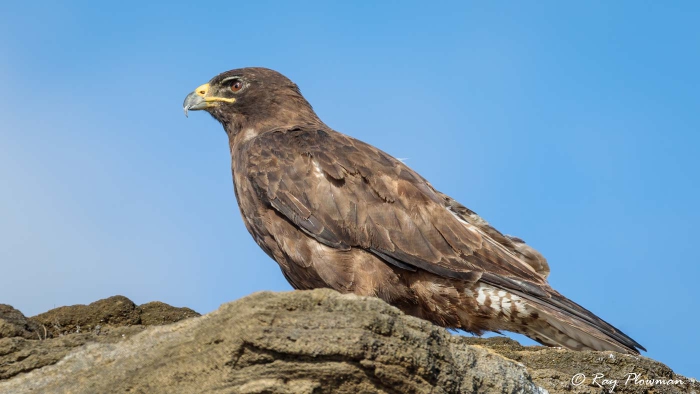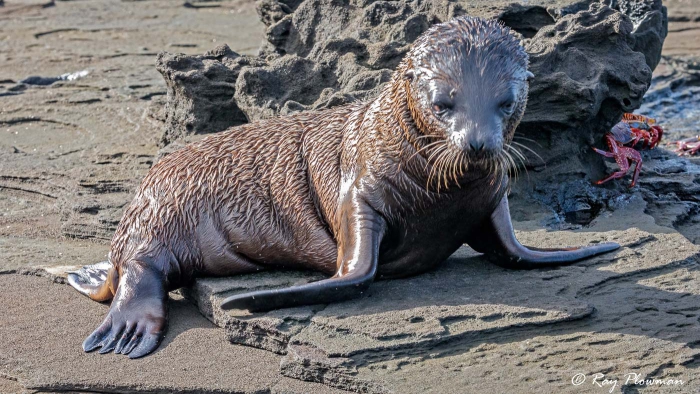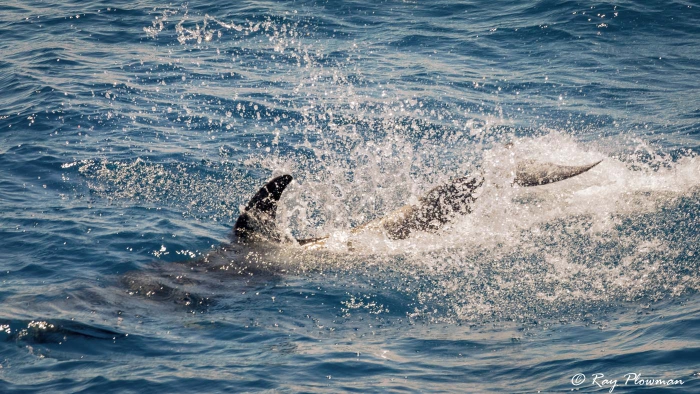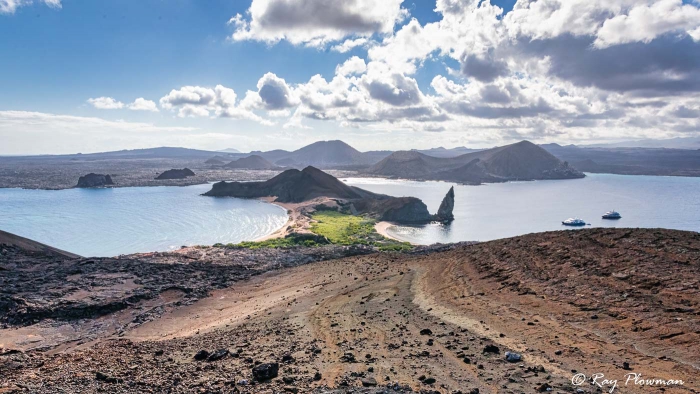Santiago – Puerto Egas and Bartolome
On day seven, we visited Santiago – Puerto Egas and Bartolome, the small island in Sullivan Bay.
Puerto Egas
Santiago (James) Island, also known as San Salvador Island, is the fourth largest island in the Galápagos. This unpopulated island has a history of natural resource exploitation, species introductions, decimating its flora and fauna. However, there are conservation programs to restore the ecological health of the island. Such as the elimination of feral pigs and the reintroduction of land iguanas (Ref 1).
After an overnight voyage from Isabela’s Punta Vicente Roca, we anchored at Puerto Egas, James Bay. Then, following an early breakfast, we made a wet landing on a small sandy beach.
Immediately we landed, I spotted a magnificent Galápagos Hawk perched on a small cliff looking for prey.

Galapagos Hawk
The endemic Galápagos Hawk (Buteo galapagoensis) is one of my favourite species.
Birds at Puerto Egas
[foogallery id=”17102″]
Birds at Puerto Egas
After photographing the Galápagos hawk at the beach, we followed the Fur Seal Grotto trail. Initially, we walked through the spares Palo Santo Forest before sighting the east coast. Furthermore, the forest area was home to Darwin’s finches, Galápagos flycatchers, doves, and mockingbirds. Along the shore were waders (shorebirds) and marine seabirds such as whimbrel and an American oystercatcher. I also photographed: a wandering tattler, ruddy turnstone, semipalmated plover, magnificent frigatebird, and lava heron.

Galapagos Fur Seal Pup
The fur seal pup (Arctocephalus galapagoensis) was on lava rocks at Puerto Egas; it is an endangered species.
Marine Wildlife at Puerto Egas
[foogallery id=”17132″]
Marine Wildlife at Puerto Egas
The voyage highlight was a couple of whales I spotted, and I photographed one close to the boat. I tried to get our park guide to help identification, but I gave up after asking for help on three occasions. I think it is a false killer whale (Ref 2), one of the five blackfish (Delphinidae). Its behaviour was like some killer whales we had seen near our boat off the south coast of Isabela. Unfortunately, I did not photograph the Orca as I was inside the boat without my camera to hand.
Cruising to Bartolome
In the late morning, we cruised from Puerto Egas on Santiago’s west coast to Isla Bartolomé on the east coast. Furthermore, it was a long daylight voyage around the north coast, arriving at the anchorage in the early afternoon. However, the cruise allowed me time to spot marine wildlife before our next excursion ashore.

False Killer Whale diving off the north coast of Santiago
The voyage highlight was a couple of whales I spotted, and I photographed one close to the boat. I tried to get our park guide to help identification, but I gave up after asking for help on three occasions. I believe it is a false killer whale (Ref 2), one of the five blackfish (Delphinidae). Its behaviour was like some killer whales we had seen near our boat off the south coast of Isabela. Unfortunately, I did not photograph the Orca as I was inside the boat without my camera to hand.
Wildlife on the Cruise to Bartolome
[foogallery id=”17134″]
Wildlife on the Cruise to Bartolome
In addition to the false killer whale, I also spotted seabirds, Nazca booby and magnificent frigatebirds flying alongside the boat.
Isla Bartolome
The most visited site in the Galápagos is Isa Bartolomé (Bartholomew) with Pinnacle Rock; it has one of the most iconic panoramas. The small island is an eroded tuff cone remnant with lava flows, spatter, and tuff cones.
After the voyage from Puerto Egas, we anchored at Isa Bartolomé in the early afternoon. Then we set off for a panga ride to photograph wildlife along the Bartolomé shore. Finally, in the late afternoon, we made a dry landing on Bartolomé.
Bartolome Landscapes and Wildlife
[foogallery id=”17136″]
Bartolome Landscape and Wildlife
The panga followed the northeast coast from Playa Dorada to Bartolomé’s southern tip, photographing great blue heron and blue-footed boobies. Then across to Sullivan Bay on Santiago to photograph lava heron. Finally, we backtracked, passing Pinnacle Rock and Playa Dorada, where endangered green turtles were nesting.
In the late afternoon, we made a dry landing on Bartolomé. Once ashore, we followed the wooden steps to the summit to photograph the iconic Galápagos panorama. The only wildlife I spotted on the island was a couple of male Santiago lava lizards.

Pinnacle Rock from Isla Bartolome Summit
Pinnacle Rock and a distant Santiago from Isla Bartolomé summit, an iconic Galápagos panorama. The volcanic landscape is barren except between the two beaches where lush vegetation of salt-tolerant plants grows.
References – Online Resources
1. Reintroduction of Land Iguanas to Santiago Island 2021. [Online] Available from Galapagos Conservation Trust [Accessed 23-Sep-21].
2. IWC False Killer Whale 2021. [Online] Available from International Whaling Commission [Accessed 23-Aug-21].